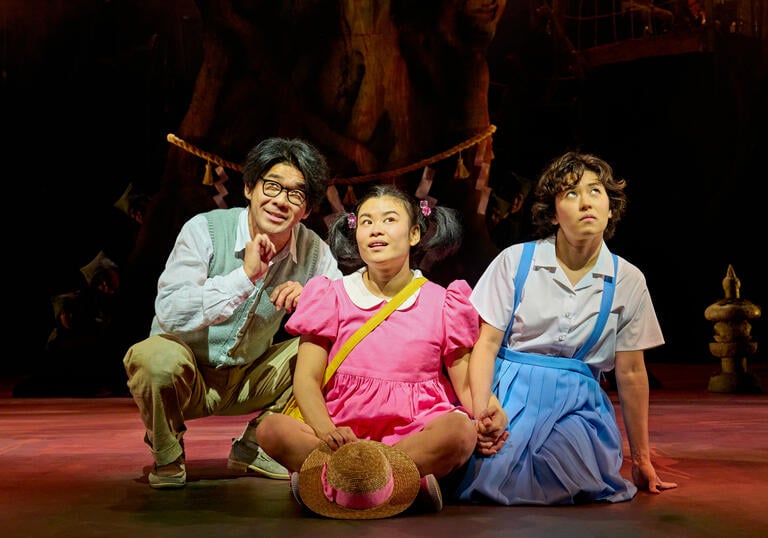How did you portray 1950s Japanese culture in the costume design in Joe Hisaishi and the Royal Shakespeare Company’s My Neighbour Totoro?
I was inspired by Hayao Miyazaki’s rough sketch of My Neighbor Totoro (1988). After World War II, American and European culture, costume, food and living styles were introduced into Japan – people wore clothes influenced by both local and Western culture.
In big cities like Tokyo, people usually wore Western clothes, and we can see this when the Kusakabe family move to the countryside; in the sketches by Miyazaki, Satsuki wears pyjamas whilst Mei opts for Japanese nightwear. In contrast, the countryside farmers wear Japanese traditional working clothes (jinbei, monpe) and Satsuki and Mei’s mother wears yukata in hospital.
The Japanese school uniform is modelled like that of European-style naval uniforms, which were first seen in late 19th century Japan, replacing the traditional kimono.
How did Studio Ghibli animations shape the design process for the costumes?
To begin with, I researched the difference between the Kusakabe and Ogaki family. The house they move into has European and Japanese influences – the father’s studio has a European chair and desk whilst the living room and bedroom are Japanese-style tatami rooms with low tables and beds on the floor. In the show, Granny teaches the children how to keep the floors clean and they take their shoes off before entering the house. Even now, many houses and apartments have both Western and Japanese inspired rooms.
The forest, wind and flowers also inspired the costume design. For Mei, Satsuki and Yasuko’s costumes, I was influenced by spring flowers (cherry blossom, wisteria, hydrangea and daffodil).
The puppeteers are wind spirits, and their costumes are based on bunraku kurogo (traditional all black costumes). I call the wind spirits “Kazego 風衣・風子” – which are designed to be both visible and invisible; they are all around us and are Totoro’s friends. The Kazego also play the farmers, so their costumes are designed with quick changes in mind. They keep the same trousers but change between dark blue costumes and indigo blue kimonos.
The musicians are tree spirits, and their costumes match the colour of the trees. The BSL interpreter’s costume for Signed performances is light blue. The Ogaki family colour is a matcha, wasabi green – especially important for Granny who lives in nature… she could see Totoro when she was a child!
Did you collaborate with Production Designer Tom Pye and Puppetry Designer and Director Basil Twist, in your design process?
I talked about the Kusakabe’s Western and Japanese influences with Tom. We also discussed props, cars, buses, lifestyle and Japanese culture more broadly. His model box was very influential when it came to costume design.
With Basil, I talked about Bunraku (traditional Japanese puppet theatre). When workshops first started at the Barbican, Basil and our director Phelim McDermott worked on prototypes for Totoro and the Catbus whilst I observed the movement of the puppeteers. Here, we discussed Kazego puppeteers – specifically, how we needed them to be half human, half Kazego and able to disappear and reappear so that Satsuki and Mei could see them.
What was the biggest challenge you faced on this project?
Mei, Satsuki and Kanta are small children played by adult performers – so the shape of their costumes is very important; balloon sleeves, bloomers, high waists and miniskirts help to make them look like a lot younger.
I respect Miyazaki’s original characters and created our theatre version with the creative team. In the same way, Tom and Basil respected the original characters, house and setting.
What advice would you give to aspiring costume designers?
The most important thing is quality and teamwork. Costume designers need to be able to work closely with the rest of the creative team and spend time researching each character deeply.
Costumes are designed for individual productions, so they should never be the same or generic – therefore, designers should not research or copy ideas from online, fashion magazines or books. Instead, it’s helpful to see live art exhibitions and walk in nature, gardens and zoos where you can see flowers, trees, insects and nature.
Personally, I like to travel to different countries to feel and discover different cultures. It is important to experience colour, landscape and architecture; to visit, travel, see and feel.
Life experiences and studies are important for creativity. As my theatre master says “we keep studying all our life”.
Look through the image gallery at the top of this page to see more of Kimie Nakano's Olivier award-winning costume designs.
Photos by Manuel Harlan © RSC with Nippon TV

